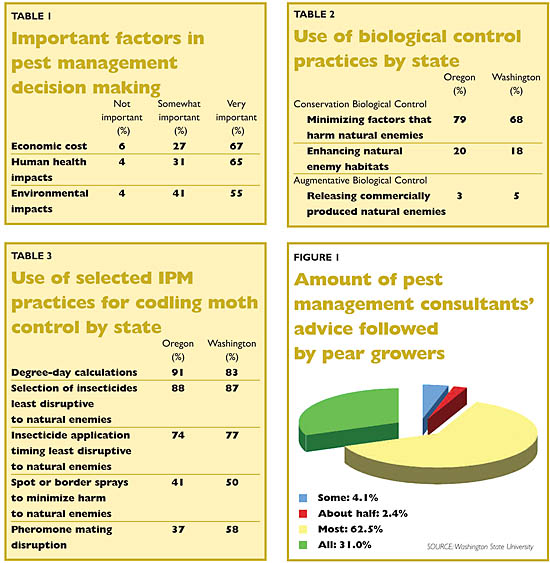Implementing stable biological control programs requires growers and pest managers to have a much better understanding of management actions against not only pests, but also their natural enemies. Sound management strategies must consider the phenology of both pests and natural enemies, but also optimal timing of management activities and selection of pesticides to result in maximum suppression of the pest, while minimizing the effects on natural enemies.
Members of the multistate project “Enhancing Biological Control in Western Orchard Systems” conducted a survey of pear growers in Oregon and Washington. The goals were to measure adoption of biological control; to better understand growers’ perceptions of the benefits and barriers to using biological control; and to obtain information about preferred outreach methods.
Who completed surveys?
Of the 1,000 Washington and Oregon pear growers contacted, 36% completed surveys. Respondents ranged in age from 23 to 85 with a mean age of 57 years. On average, respondents had spent 25 years involved in pear production. More than half (53%) of respondents had a four-year college degree, and 19% had attended graduate school.
The majority (89%) of survey respondents were orchard owners, partners, or lessees, while 9% were hired managers. Respondents operated, on average, 140 acres of farmland, including 46 acres of pears. The most popular pear varieties were d’Anjou, Bartlett, and Comice. Twenty-six percent of respondents had less than $50,000 in gross income from pear production; 41% reported $50,000 to $249,999; 25% reported $250,000 to $999,999; and 8% reported $1 million or more.
How do growers make pest management decisions?
Pear growers consider economic cost, human health impacts, and environmental impacts to varying degrees when making pest management decisions for their orchards (see Table 1).
The most common sources of information for making pest management decisions for growers were agricultural chemical distributor field horticulturists; insecticide label information; packing warehouse field horticulturists; formal education and continuing education classes; and industry-sponsored conferences, workshops, and seminars. Washington respondents placed significantly greater importance on packing warehouse field horticulturists and university Web sites, while Oregon respondents placed more importance on field days and farm tours.
Ninety percent of respondents used the services of some type of pest management consultant. Most respondents followed all or most of the advice that those consultants provided (see Figure 1).

Most pear growers reported using computers for their farm business (93% in Oregon and 82% in Washington), while fewer used smartphones (34% in Oregon and 22% in Washington). Nearly 75% of respondents reported regularly accessing the Internet for farm information.
How widespread is use of biological control?
Three-quarters of the survey respondents relied on one or more biological control practices to control insect pests. In both states, strategies to minimize factors that harm natural enemies were more commonly used than ways to enhance natural enemy habitats or releasing commercially produced natural enemies (see Table 2).
Adopters, on average, had been using a form of conservation biological control for ten years and augmentative biological control for five years.
Although 25% of the respondents did not practice biological control, two-thirds of them were somewhat or very familiar with the concept. Growers from both states indicated interest in learning more about biological control (46% and 65% of Oregon and Washington nonadopters, respectively).
What are the perceived benefits and barriers to biological control adoption?
Pear growers who relied on biological control practices perceived many benefits to using biological control. These were, primarily, reduced pesticide use, reduced input costs, environmental protection, worker health, and increased natural enemies.
Pear growers who did not rely on biological control practices provided many different reasons for their nonadoption. The primary adoption barriers were perceived ineffectiveness, lack of adequate knowledge, and high cost. Some growers said their nonadoption was due to field horticulturists not recommending biological control practices.
What other integrated pest management practices do pear growers use?
All survey respondents reported that they, their employees, field horticulturists, private consultants, and/or other individuals monitored their pear orchards for insects. Eighty percent of Oregon growers and 71% of Washington growers indicated that agricultural chemical distributor field horticulturists were responsible for insect monitoring in their orchards.
Pear growers used an assortment of other integrated pest management (IPM) practices to control for codling moth in their orchards (see Table 3).
How do growers want to receive pest management information in the future?
Survey respondents were asked about their preferred methods for receiving information on pest management in pears in the coming years. Growers preferred printed materials, Internet, in-person meetings, and field days. The least preferred methods for receiving information were social media, online meetings or workshops, online courses, and in-person courses. Oregon growers were significantly more interested in in-person courses, field days, and e-mail compared with Washington growers.
As the project nears completion, team members will take these preferences, as well as growers’ perceptions of the benefits and barriers to biological control adoption, into consideration during the development of future educational products and outreach activities.
This is the seventh article in an eight-part series highlighting results of a five-year USDA Specialty Crop Research Initiative project to enhance biological control of orchard pests. The project involves researchers Washington State University, Oregon State University, University of California Berkeley, and the U.S. Department of Agriculture in Yakima, Washington.
Leave A Comment